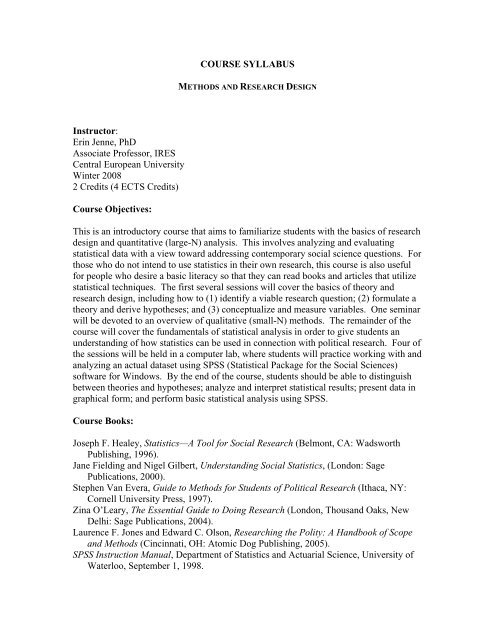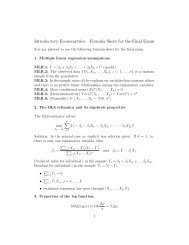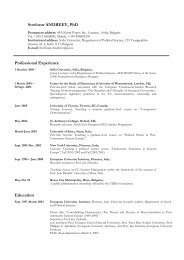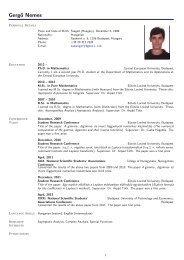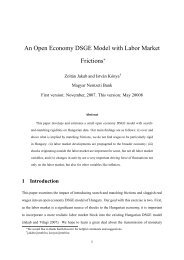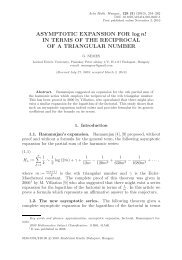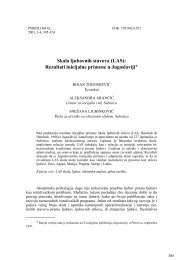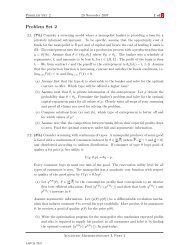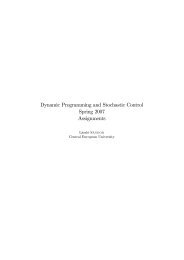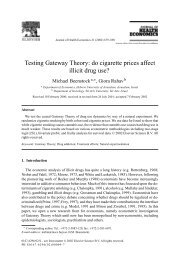course syllabus - Personal pages of the CEU - Central European ...
course syllabus - Personal pages of the CEU - Central European ...
course syllabus - Personal pages of the CEU - Central European ...
You also want an ePaper? Increase the reach of your titles
YUMPU automatically turns print PDFs into web optimized ePapers that Google loves.
COURSE SYLLABUS<br />
METHODS AND RESEARCH DESIGN<br />
Instructor:<br />
Erin Jenne, PhD<br />
Associate Pr<strong>of</strong>essor, IRES<br />
<strong>Central</strong> <strong>European</strong> University<br />
Winter 2008<br />
2 Credits (4 ECTS Credits)<br />
Course Objectives:<br />
This is an introductory <strong>course</strong> that aims to familiarize students with <strong>the</strong> basics <strong>of</strong> research<br />
design and quantitative (large-N) analysis. This involves analyzing and evaluating<br />
statistical data with a view toward addressing contemporary social science questions. For<br />
those who do not intend to use statistics in <strong>the</strong>ir own research, this <strong>course</strong> is also useful<br />
for people who desire a basic literacy so that <strong>the</strong>y can read books and articles that utilize<br />
statistical techniques. The first several sessions will cover <strong>the</strong> basics <strong>of</strong> <strong>the</strong>ory and<br />
research design, including how to (1) identify a viable research question; (2) formulate a<br />
<strong>the</strong>ory and derive hypo<strong>the</strong>ses; and (3) conceptualize and measure variables. One seminar<br />
will be devoted to an overview <strong>of</strong> qualitative (small-N) methods. The remainder <strong>of</strong> <strong>the</strong><br />
<strong>course</strong> will cover <strong>the</strong> fundamentals <strong>of</strong> statistical analysis in order to give students an<br />
understanding <strong>of</strong> how statistics can be used in connection with political research. Four <strong>of</strong><br />
<strong>the</strong> sessions will be held in a computer lab, where students will practice working with and<br />
analyzing an actual dataset using SPSS (Statistical Package for <strong>the</strong> Social Sciences)<br />
s<strong>of</strong>tware for Windows. By <strong>the</strong> end <strong>of</strong> <strong>the</strong> <strong>course</strong>, students should be able to distinguish<br />
between <strong>the</strong>ories and hypo<strong>the</strong>ses; analyze and interpret statistical results; present data in<br />
graphical form; and perform basic statistical analysis using SPSS.<br />
Course Books:<br />
Joseph F. Healey, Statistics—A Tool for Social Research (Belmont, CA: Wadsworth<br />
Publishing, 1996).<br />
Jane Fielding and Nigel Gilbert, Understanding Social Statistics, (London: Sage<br />
Publications, 2000).<br />
Stephen Van Evera, Guide to Methods for Students <strong>of</strong> Political Research (Ithaca, NY:<br />
Cornell University Press, 1997).<br />
Zina O’Leary, The Essential Guide to Doing Research (London, Thousand Oaks, New<br />
Delhi: Sage Publications, 2004).<br />
Laurence F. Jones and Edward C. Olson, Researching <strong>the</strong> Polity: A Handbook <strong>of</strong> Scope<br />
and Methods (Cincinnati, OH: Atomic Dog Publishing, 2005).<br />
SPSS Instruction Manual, Department <strong>of</strong> Statistics and Actuarial Science, University <strong>of</strong><br />
Waterloo, September 1, 1998.
Course Requirements:<br />
Short readings will be assigned for each class. The <strong>course</strong> grade is broken down as<br />
follows:<br />
(1) Problem Sets (80%). Students will be expected to complete problem sets every week,<br />
which involve simple numeric computations and (in some cases) very short essays.<br />
Students are asked to show <strong>the</strong>ir work in <strong>the</strong>se assignments—partial credit will be<br />
given to incorrect answers if <strong>the</strong> basic work is correct. Please note that it is important<br />
to do your own work: <strong>the</strong>re are strict penalties for copying problem sets.<br />
(2) Participation (20%). Students are expected to attend all seminars and actively<br />
contribute to class discussions.<br />
COURSE SCHEDULE<br />
Seminar 1: Research Question and Literature Review (O’Leary, pp. 28-41; 66-84)<br />
Seminar 2: Elements <strong>of</strong> Research Design (Buttolph and Johnson, pp. 33-60)<br />
• Hypo<strong>the</strong>ses and Theories<br />
• Independent, Intervening, Dependent Variables<br />
• Data, Variables, Values<br />
• Examples from International Relations<br />
Seminar 3: Overview <strong>of</strong> Qualitative Research (Van Evera, pp. 49-70)<br />
• Qualitative versus Quantitative Analysis<br />
• The Comparative Method<br />
• Congruence Procedures<br />
• Process-tracing<br />
• Crucial Cases<br />
Seminar 4: The Basics <strong>of</strong> Data Analysis (Healey, pp. 7-9; Jones and Olson, pp. 181-194)<br />
• Descriptive v. Inferential Data Analysis<br />
• Measuring Variables (validity, reliability, replicability)<br />
• Types <strong>of</strong> Variables (nominal, ordinal, interval)<br />
• Common Terms (dataset, population sample, parameter, statistic)<br />
• Misuses <strong>of</strong> Data (examples)
Seminar 5: Univariate (Descriptive) Statistics (Jones and Olson, pp. 247-267)<br />
• Sample Size (N)<br />
• Range<br />
• Frequency Distributions<br />
• Histograms<br />
• O<strong>the</strong>r Charts<br />
• Measures <strong>of</strong> <strong>Central</strong> Tendency and Dispersion<br />
‣ Means, medians, modes<br />
‣ Variance, standard deviation<br />
Seminar 6 (LAB): Introduction to SPSS for Windows (Jones and Olson Workbook, pp. 1-9, 139-148)<br />
• Starting an SPSS Session<br />
• Creating a New Dataset<br />
• Using an Existing Dataset<br />
• Manipulating and Merging Datasets<br />
• Importing and Exporting Data<br />
• Printing Datasets<br />
• Descriptive Statistics in SPSS (mean, standard deviation, variance, range,<br />
frequencies)<br />
Seminar 7 (LAB): Manipulating Data in SPSS (Jones and Olson Workbook, pp. 11-17)<br />
• Recoding and Transforming Variables<br />
• Graphs and Charts<br />
‣ Scatterplots<br />
‣ Histograms<br />
‣ Box Plots and O<strong>the</strong>r Charts<br />
‣ Cross-tabulations<br />
• Printing and Saving Output<br />
Seminar 8: Probabilities and Sampling (Healey, pp. 116-124; 138-147)<br />
• Binomial and Normal Random Variables<br />
• The Meaning <strong>of</strong> “Normal”<br />
• Z-scores<br />
• Using <strong>the</strong> Normal Table<br />
• O<strong>the</strong>r distributions<br />
• Methods <strong>of</strong> Sampling<br />
‣ Systematic Sampling<br />
‣ Random Sampling<br />
• Sampling Error<br />
Seminar 9: Hypo<strong>the</strong>sis-testing (Healey, pp.152-168; 173-195)<br />
• Confidence Intervals<br />
• Estimation Procedures<br />
• Null and Alternative Hypo<strong>the</strong>ses<br />
• One and Two-Tailed Tests
Seminar 10: Bivariate Correlation and Regression (Fielding and Gilbert, pp. 161-182)<br />
• Introduction to Bivariate Analysis<br />
• Covariance and <strong>the</strong> Correlation Coefficient<br />
• Graphing <strong>the</strong> Function<br />
• Regression and <strong>the</strong> Method <strong>of</strong> Ordinary Least Squares (OLS)<br />
• Interpreting Regression Statistics (Beta Coefficient and R-Squared)<br />
Seminar 11 (LAB): Bivariate Regression Analysis in SPSS (Fielding and Gilbert, pp. 182-197)<br />
• Correlations<br />
• Bivariate Regression Analysis<br />
• Interpreting <strong>the</strong> Statistics<br />
• Presenting <strong>the</strong> Data<br />
Seminar 12 (LAB): Multivariate Regression Analysis in SPSS (Jones and Olson, pp. 307-321)<br />
• Introduction to Multivariate Regression Analysis<br />
• When to use Multivariate Regression<br />
• Control Variables<br />
• Goodness <strong>of</strong> Fit (R-squared statistic)<br />
• Interpreting <strong>the</strong> Statistics


